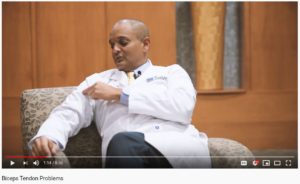Many patients in our office come in thinking they have some kind of tear in their shoulder. What we often find, is that they have biceps tendinitis.
What is biceps tendinitis?

Biceps tendinitis is the inflammation of the ‘tendon’ that connects your biceps muscle in the upper arm to the glenoid socket inside the shoulder. Also called the long head of the biceps tendon (LHBT), this cord-like structure helps your arm to rotate and bend. Biceps tendinitis is usually caused by wear and tear of the shoulder or by overuse from repeating the same shoulder motions.
Symptoms may include weakness and pain in the front of the shoulder, especially with rotational use of the arm, i.e. taking a shirt off, reaching the back seat of a car, putting a bra on, putting a seat-belt on. The area may be tender to the touch and pain might be intermittent. Discomfort may become worse when you bend your arm or use it to reach over your head. You may also hear or feel a snap.
How is biceps tendinitis treated?
The first line of treatment is always to rest the shoulder and avoid activities that cause pain. You may ice the area and try over the counter medications like ibuprofen and naproxen to ease the pain and inflammation. Patients with this condition typically benefit from an ultrasound guided cortisone injection which can be very effective in reducing both inflammation and pain. You may also be directed to try specific physical therapy exercises to stretch, strengthen and restore mobility to the area.
If these non-surgical options do not provide relief, and the pain significantly interferes with your daily life, you may need to consider surgical treatment.
Can tendinitis turn into a tear?
In most cases, tendinitis will resolve within six months to a year. But if overuse continues to be a problem, it is possible to develop a tear. There are degrees of biceps tears and many people live with minor tearing without problem.
What is a biceps tear?
A partial or full tear of the biceps tendon is caused by injury or overuse. The tendon is usually prone to injury as it runs through the shoulder joint and connects to the rim of the socket. The biceps muscle is also attached by a short head that rarely tears. People are still able to use their shoulder even when the long head is injured.
Overuse is one of the causes of many shoulder problems, from tendinitis to tears and rotator cuff injuries. Small tears can happen as the shoulder is repeatedly used in the same way over and over through the years. As the shoulder tendons weaken over time and with aging, they become more prone to tearing. Fortunately, for many people, the pain from a biceps tendon tear will resolve on its own. Non-surgical treatments such as ice, anti-inflammatory medications, rest or physical therapy can help.
The condition is generally diagnosed by specific physical examination in the office. While magnetic resonance imaging (MRI) may be helpful to rule out other more serious shoulder problems, an MRI will not show all tears. MRIs will miss tears in the long head biceps tendon approximately 60% of the time.
Dr. Gobezie published a study on MRI accuracy in detecting tears. The objective was to evaluate the accuracy of non-contrast MRI compared to arthroscopy for the diagnosis of pathology involving the intra-articular portion of the LHBT. The study concluded that “standard non-contrast MRI of the shoulder is limited in detecting partial tears and complete ruptures of the intra-articular LHBT.”
Surgeons may encounter pathologic lesions of the LHBT during arthroscopy that are not visualized on the MRI. Ultimately, this means that a surgeon may need to use arthroscopy to best determine the severity of the tear or treat the patient based on their physical symptoms.
WATCH VIDEO:
Dr. Gobezie describes the 3 most common biceps problems
The Gobezie Shoulder Institute treats patients with all types of shoulder and elbow disorders resulting from traumatic injuries, arthritis, instabilities, rotator cuff and sports-related injuries. Led by nationally recognized Orthopedic Surgeon Reuben Gobezie, MD, the institute provides both surgical and non-operative treatments.
Dr. Gobezie is one of the country’s top specialists in advanced arthroscopic and open surgical techniques to restore damaged joints, ligaments and bones. He is also one of the most experienced and highest volume shoulder surgeons in the country. A number of studies have shown that surgical volume, the number of surgeries a surgeon performs each year, is a strong predictor of patient outcome. The more surgeries that a doctor and his surgical team performs, the better the results for patients.
Dr. Gobezie is Founding Director of both Gobezie Shoulder Institute and Regen Orthopedics. He also co-founded Genie Health in 2018.
